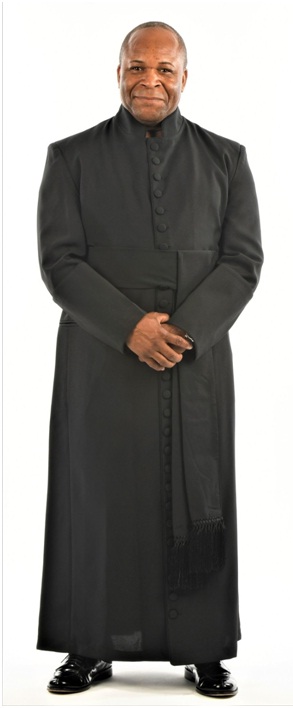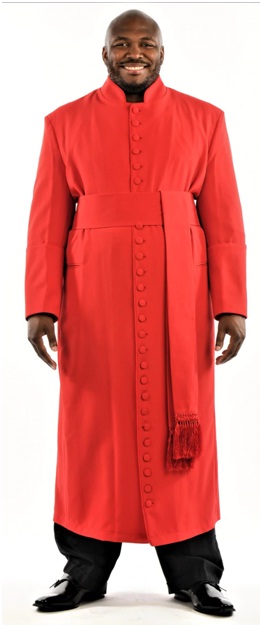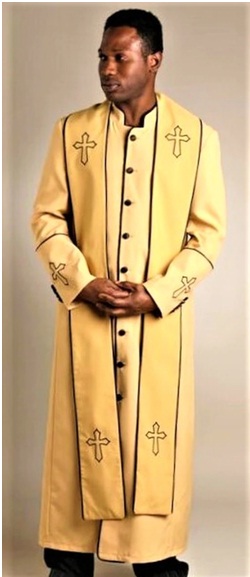A History of The Cassock
Sep 22nd 2020

Here at Divinity Clergy Wear, we deal in “wares” that go by relatively common names. In order to recognize and truly understand the different names of the garments that we offer here, you would probably need to be a member of clergy, active in a church, or well-versed in the history of the church or of clerical vestments.
For anyone else, many of these names are likely to run together. Names like “alb,” “surplice,” and “stole” probably have little meaning for anyone that isn’t familiar with the more popular vestments, and there are many other esoteric ones beside these.
One of them, and one that is very widely used, is the cassock, which often is traditionally worn with a special belt known as a cincture. Their use is widespread enough today, and they are recognizable enough on sight where not by name, but just why are they called what they are called, and where did they come from?
Origins
Like many other clerical vestments, there are some conflicting theories on where, exactly cassocks originated and why. However, unlike other vestments like the stole, there are better accounts of where they came from, and some canonical historians are more assured of the veracity of these accounts.
Also like several other vestments that have been absorbed into the church and are now effectively reserved for clerical use, this garment may have secular origins. One theory posits that it is a descendant of a long, heavy garment, similar to a coat, that was once worn by nobles of continental Europe. It has been claimed that this coat was primarily developed as a form of protection against the elements, and that the name “cassock” itself is derivative of the French for a form of the garment. That much, at least, would explain the length and completeness of the covering that modern versions provide.
There is another theory stating that this garment as we know it today originated from a Roman garment that was worn by the nobility and as a form of their dress distinguished them as such. The nobles were in the habit of wearing a long tunic and a toga whereas the laity more commonly wore short tunics and pants. As the divide between the dress of the nobles and laypeople continued to grow, the image of the long tunic which may have become them grew as well.
This theory, though it does not necessarily offer an explanation for the modern name associated with the vestment, does explain how it came to become adopted by the church. As many early members of the Catholic church would have been nobles, they may have worn similar garments.
In addition, it has been recorded in various annals, pursuant to councils that occurred in Medieval Europe, that short hemmed garments were not seen as appropriate for members of the clergy. Not only was the general Christian European populace distasteful of short hemmed vestments for clergymen and altar servers, but several councils that occurred throughout the Middle Ages actually required clergymen to wear long hemmed garments that covered the legs.
Several councils actually prescribed canonical law requiring members of the church to apparel themselves in long garments that were required to be joined at the front; this gave rise to the use of a belt that has in modern times come to be known as a cincture that is so commonly paired with a cassock. To tell the entire story, it was not just the length of these garments that was prescribed and regulated, but actually every facet of their features as well, including their specific ornamentation.
That is the reason, therefore, that so many versions of these garments are gathered and joined in the front by cinctures, and also the reason that they are buttons down the front. Each of these features, along with the length of the vestment, was specified in great detail pursuant to several decrees that were passed in succession on the subject.
Today, it is a very recognizable liturgical vestment that is worn by several different officials, depending on rank and responsibility. The reality of the situation is that the origin of the original cassocks is some combination of the historical events that we described herein, and not a linear occurrence. For example, it is likely that today’s vestments of this name were developed over time, taking features from the secular cloaks detailed at the outset of this section, and slowly repurposed over time.
Who Wears the Cassock
Due to the fact that the cassock is sometimes worn by members of the Roman Catholic Church when not engaged in clerical duties, there are some who do not consider it a proper vestment. With that in mind, for the purpose of this investigation we will.
As the Roman Catholic Church was the first organized church, the first clergymen who wore such a garment were members of that same church. At certain points in history, clergy members of the Roman Catholic Church were required to wear them at all times, whether engaged in duties or in secular life. This reinforces the idea that they may have derived from a secular garment to protect the wearer against the elements, as the modern version does the same. However, it also confers a spirit of reverence and respect, as it is in most cases and unadorned, plainly colored ankle length garment.
In the event that a clergy member were to wear them while engaged in clerical duties, it would be paired with other vestments such as an alb or chimere; but this depends on the situation and the officiation of any ceremony in question.
After the several schisms that produced the Eastern Orthodox church as well as many different branches of protestantism, the role of the cassock was adopted into these different areas of the new churches.
For example, in the Eastern Church, there is a garment worn by members of the clergy called a Rhason. This garment is very similar to the cassock not only in appearance but also in function. Though they go by different names, an Eastern clergyman, such as a member of the Russian Orthodox Church, would wear the Rhason under similar circumstances to which a Roman Catholic Priest would wear a cassock.

Similarly, when the Church of England split from the Roman Catholic Church, they preserved the use of the cassock. At first, it remained the everyday dress of the ordained members of the clergy, but over time the usage became more relaxed. It is still worn when in church or occasionally as the walking dress within the parish, but it is no longer required to be worn all the time.
Those who still make use of them can choose to use it as their everyday dress, and in some churches, it is required to be worn by members of the church when in church but not serving. More commonly, however, it is the foundational garment that is worn underneath the other vestments.
Different Colors
There is a rich history of color symbolism that is involved with the presentation of the many different clerical garments that you will find on our website and elsewhere, and not only including vestments. This applies to the cassock as much as it applies to other garments, and if you want to learn a little bit more about it in depth, there are plenty of great resources available on the subject. Alternatively, you could call us and we’d be glad to get into the details of what all the different colors of vestments mean and why they matter.
It is highly likely that the most commonly encountered color you will find in them is black, although it is not the only one. There is a good reason for this and it goes far back into history. In fact, for the very reasons that we are going to uncover, black is equally commonly encountered in other vestments as well.
Some people see black as a dour color, but the reason that it is so commonly seen as a fitting mate for a cassock is because it serves as a reminder that the duties of clergymen are not only holy. They are also secular, and as priests and other clergymen can be seen as sorts of intermediaries between God and the members of a congregation, it is important to send a reminder that though a man may serve a holy office, he also serves the world.
Therefore the color black is a humbling reminder of the Earthly duties of an ordained man; that he is not above the fray but a part of it. These members of the Church are ordained to guide the flock to salvation, and the color black is their reminder.
The color red is another color that you will sometimes encounter in these as well as in other garments. Frequently red is used to connote passion, heat, fire or blood, and in some ways, this is the case here as well. The color red can be seen to represent the “Passion” of the savior or of the blood that was spilled in order to gain our salvation. For this reason, there are many examples of red cassocks out there, and after the color black, red is probably the second most frequently encountered color.
There are other colors that have been traditionally paired with them, among them purple and blue. We will discuss purple and blue here together simply for the fact that for the most part these colors represent the same thing. Purple, and to a lesser extent, blue, are symbols of royalty and kingliness. That is the reason that some blues are known as royal blue, for example.

The reason for this, as well as the reason that purple has come to connote royalty, is because the ancient Phoenicians made a special dye that was very expensive to produce and turned their garments purple. These garments became so famous in the ancient world that even today the color purple is associated with royalty. There is also the idea of the image of the Lord as king, and the colors blue and purple represent this as well.
There are other colors that are commonly encountered in other vestments, but as far as our catalog of cassocks is concerned, these are the main colors you will find. Additionally, for the most part, you can accomplish these impressions with other vestments and reserve the color black for this garment. Most of them are black as we stated, anyway.
Don’t Miss Our Other Vestments and Clerical Wear
While you’re shopping here at Divinity Clergy Wear for a cassock, don’t forget that we offer many other types of vestments in our online shop. Whether you’re looking for a Robe & Stole Set or something specialized like a Rochet, Chimere, Alb or Surplice, you can find many options on our website.
You can also find many fine clergy shirts for men and women as well as a full line of preaching dresses and church dresses for ladies. In our catalog you will be dazzled by everything from the plainest and most austere garments to inspire reverence to the most impressive contemporary designs that the market has to offer. Take a look through our collection and make sure you reach out to us if you need any help.
Call Us for More Information!
If you want to learn more about what a cassock is, where its use is appropriate, or you have any other questions that were not answered herein, be sure to visit us in our showroom or give us a call. We offer many of the vestments that we investigated here in this article in our showroom that is conveniently located in Hamilton, New Jersey. Sometimes you need to get familiar with a product before buying it, and we’d love to see you in our store!
Alternatively, you can call us at 877-453-3535 and we’d be more than happy to answer any outstanding questions that remain. Get in touch with us today and we’ll shed some light on the interesting history behind so many of these unique vestments and other clerical accessories.